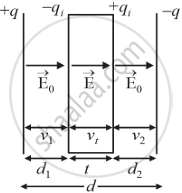Advertisements
Advertisements
प्रश्न
Find the expression for the capacitance of a parallel plate capacitor of plate area A and plate separation d when
- a dielectric slab of thickness t and
- a metallic slab of thickness t,
where (t < d) are introduced one by one between the plates of the capacitor. In which case would the capacitance be more and why?
उत्तर
I. The capacitance of a parallel plate capacitor with dielectric slab (t < d)

+q, −q = The charges on the capacitor plates
+qi, −qi = Induced charges on the faces of the dielectric slab
E0 → Electric field intensity in air between the plates
E → The reduced value of electric field intensity inside the dielectric slab.
When a dielectric slab of thickness t < d is introduced between the two plates of the capacitor, the electric field reduces to E due to the polarisation of the dielectric. The potential difference between the two plates is given by
V = V1 + Vt + V2
V = E0d1 + Et + E0d2 ...(1)
Here E is the reduced value of electric field intensity, `vecE = vecE_0 + vecE_i`.
Here `vecE_i` is the electric field due to the induced charges [+qi and −qi].
E = `sqrt(E_0^2 + E_i^2 + 2E_0E_i cos180^circ)`
= `sqrt((E_0 - E_i)^2)`
E = E0 − Ei
Also, the dielectric constant K is given by,
`K = E_0/E` ...(2)
`E_0 = sigma/epsilon_0 = q/(Aepsilon_0)` ...(3)
From equations (1), (2) and (3)
`V = E_0[d_1 + d_2] + E_0/Kt`
`V = q/(Aepsilon_0)[d - t + t/K]` ...(4)
The capacitance of the capacitor on the introduction of the dielectric slab is
`C = q/V` ...(5)
From (4) and (5)
`C = (epsilon_0A)/(d - t + t/k)`
If t = d, then `C = k(epsilon_0A)/(d)` ⇒ C = KC0
Here `C_0 = (epsilon_0A)/d`
Since K > 1, therefore C > C0
II. For a metallic slab, K is infinitely large, therefore `C = (epsilon_0A)/(d - t)`.
